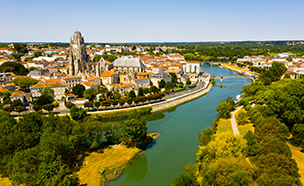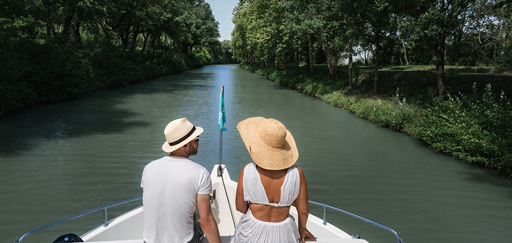Ireland is fascinating in many different ways. With its luxuriant green landscapes, lakes and Celtic heritage, this country has so much to offer visitors. Ireland was never conquered by the Romans and so for eight hundred years it remained one of the most dynamic centres of Celtic culture, until the 6th century when it was converted to Christianity by Saint Patrick.
When you set off on your Pénichette® canal boat from the base, you’ll be able to visit a whole range of areas in your exploration of Celtic Ireland. The entire island has lots of wonderful remains of Celtic architecture; you’ll have no trouble finding dolmens, Celtic crosses or tumuli, wherever you go.
Clonmacnoise Monastery
As you glide down the River Shannon during your river cruise in Ireland, to the south of the town of Athlone, you’ll come across Clonmacnoise Monastery, sometimes known as the Seven Churches. It was founded in 545 and built on the highest point of an ‘esker’ (a ridge of sand and gravel). Its location means that it has panoramic views over the Shannon and the rest of County Offaly. It is made up of a ruined cathedral, eight churches and two round towers. These magnificent ruins are easily accessible from the banks of the Shannon, not far from Athlone. The cathedral has wonderful acoustics: if you want to try it out, just whisper! Each of the eight churches on the site has its own particular characteristics. The Temple Finghín is a Romanesque church, built in the 12th century, and has a round tower that is thought to have housed ancient books and, more particularly, to have been used as safe storage for certain manuscripts that are very important and rare on account of their illumination and calligraphy. The Temple Connor church was requisitioned by the Church of Ireland so that Anglican worship could be officially celebrated there. On this historic site, you can also find three Celtic crosses. The Northern Cross is the oldest on the site; the Southern Cross is decorated with interlacing patterns, whilst the Sculpted Cross is finely carved with a text that is thought to be a prayer for Flann, High King of Ireland.
The Castlestrange Stone
The Castlestrange Stone, a granite megalith, has a number of unusual features. Located in County Roscommon, this is a protected national monument. It’s a stone with many spiral carvings, dating from the Iron Age. These carvings were done by hand using tools of the period. In order to protect it from the ravages of time and the thousands of visitors, it’s been set upon a concrete plinth. This site is certainly worth a visit. Still today, a host of researchers offer a wide range of theories to explain the intended purpose of this mysterious megalith. You could also take a trip along the banks of the Shannon to explore the history of this Iron Age site.
Walking through the Irish countryside
Ireland exerts a natural fascination, and it’s not difficult to see why. With peat bogs, breath-taking landscapes and a boundless sense of freedom, walkers can spend hours enjoying what Ireland has to offer. The wind will turn your cheeks a healthy pink and the summer sun will warm your back, but watch out when you’re walking in the peat bogs, nature can sometimes catch you out!
Ireland is full of Celtic treasures. Wherever you go in this land of enchantment, Celtic crosses will be milestones along your way!
One more thing, if you are a fishing addict, have a quick look to our previous blog post which tells the story of three brothers who cruised in Ireland for fishing.

















![Home_GB[1]](https://www.locaboat.com/wp-content/uploads/2025/02/Home_GB1.png)



